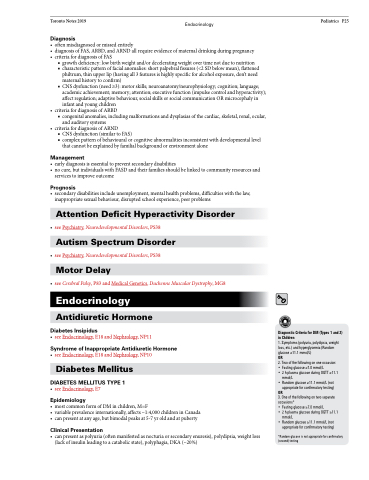Page 1059 - TNFlipTest
P. 1059
Toronto Notes 2019 Endocrinology
Diagnosis
• oftenmisdiagnosedormissedentirely
• diagnosisofFAS,ARBD,andARNDallrequireevidenceofmaternaldrinkingduringpregnancy • criteriafordiagnosisofFAS
■ growth deficiency: low birth weight and/or decelerating weight over time not due to nutrition
■ characteristic pattern of facial anomalies: short palpebral fissures (<2 SD below mean), flattened
philtrum, thin upper lip (having all 3 features is highly specific for alcohol exposure, don’t need
maternal history to confirm)
■ CNS dysfunction (need ≥3): motor skills; neuroanatomy/neurophysiology; cognition; language;
academic achievement; memory; attention; executive function (impulse control and hyperactivity); affect regulation; adaptive behaviour, social skills or social communication OR microcephaly in infant and young children
• criteriafordiagnosisofARBD
■ congenital anomalies, including malformations and dysplasias of the cardiac, skeletal, renal, ocular,
Pediatrics P25
and auditory systems
• criteriafordiagnosisofARND
■ CNS dysfunction (similar to FAS)
■ complex pattern of behavioural or cognitive abnormalities inconsistent with developmental level
that cannot be explained by familial background or environment alone
Management
• earlydiagnosisisessentialtopreventsecondarydisabilities
• nocure,butindividualswithFASDandtheirfamiliesshouldbelinkedtocommunityresourcesand
services to improve outcome
Prognosis
• secondarydisabilitiesincludeunemployment,mentalhealthproblems,difficultieswiththelaw, inappropriate sexual behaviour, disrupted school experience, peer problems
Attention Deficit Hyperactivity Disorder
• seePsychiatry,NeurodevelopmentalDisorders,PS38 Autism Spectrum Disorder
• seePsychiatry,NeurodevelopmentalDisorders,PS38 Motor Delay
• seeCerebralPalsy,P83andMedicalGenetics,DuchenneMuscularDystrophy,MG8 Endocrinology
Antidiuretic Hormone
Diabetes Insipidus
• seeEndocrinology,E18andNephrology,NP11 Syndrome of Inappropriate Antidiuretic Hormone
• seeEndocrinology,E18andNephrology,NP10 Diabetes Mellitus
DIABETES MELLITUS TYPE 1
• seeEndocrinology,E7
Epidemiology
• mostcommonformofDMinchildren,M=F
• variableprevalenceinternationally,affects~1:4,000childreninCanada • canpresentatanyage,butbimodalpeaksat5-7yroldandatpuberty
Clinical Presentation
• canpresentaspolyuria(oftenmanifestedasnocturiaorsecondaryenuresis),polydipsia,weightloss (lack of insulin leading to a catabolic state), polyphagia, DKA (~20%)
Diagnostic Criteria for DM (Types 1 and 2) in Children
1. Symptoms (polyuria, polydipsia, weight loss, etc.) and hyperglycemia (Random glucose ≥11.1 mmol/L)
OR
2. Two of the following on one occasion: • Fasting glucose ≥7.0 mmol/L
• 2 h plasma glucose during OGTT ≥11.1
mmol/L
• Random glucose ≥11.1 mmol/L (not
appropriate for confirmatory testing)
OR
3. One of the following on two separate occasions*
• Fasting glucose ≥7.0 mmol/L
• 2 h plasma glucose during OGTT ≥11.1
mmol/L
• Random glucose ≥11.1 mmol/L (not
appropriate for confirmatory testing)
*Random glucose is not appropriate for confirmatory (second) testing


